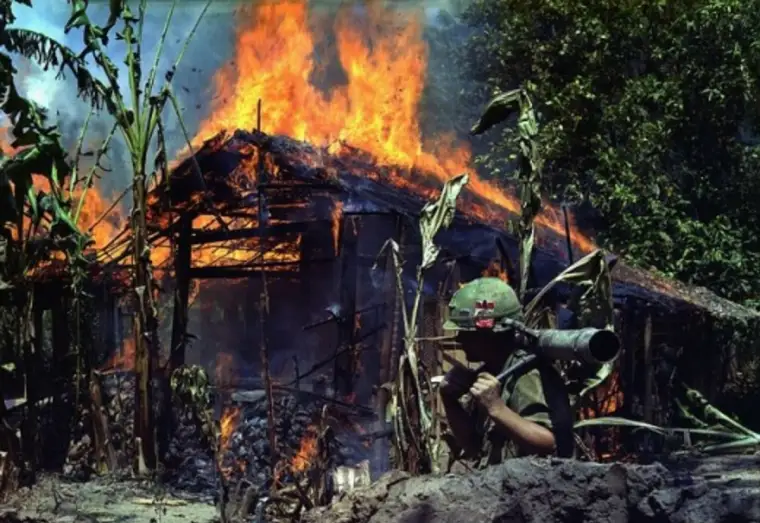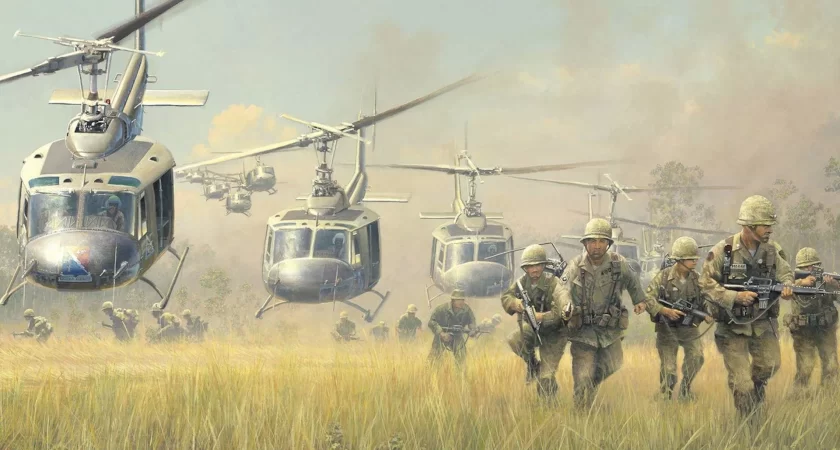When the troops from Charlie company arrived in Vietnam in December 1967, they instantly bonded with the locals. The first few weeks featured more socialising than any actual fighting. This was not the War they were expecting, and it was great. But all that would change over the next few months.
Unlike in the first and second World Wars, this conflict did not feature large, heavily armed battalions fighting other large, heavily armed battalions, this was more akin to battalions fighting ghosts. The Viet Cong (South Vietnamese fighters allied to the Army of North Vietnam) blended in with the populace, and moved silently through the jungle.
They pragmatically employed guerilla tactics which drove the Americans crazy. A booby trap here, A sniper attack there, and when the Americans responded by peppering the surrounding jungle with machine gun fire, they often hit nothing.
Payback
The American Soldiers were mad, and somebody was going to pay for their losses. Which brings us to Pinkville. This was a region in the Quang Ngai province of South East Vietnam, so named by the yanks because it was coloured in pink on all of their military maps.
January 1968, saw an escalation by the Communist forces against the South Vietnamese and their US Allies. The “Tet offensive” – a sneak attack launched during lunar new year celebrations – saw over 100 towns attacked in the South. It was part of a 3 phased attack, which started on the night of January 30, and continued until late September.
Pursuit
The Tet Offensive didn’t produce the result the Viet Cong and the North Vietnamese Army were after, so they returned to guerilla tactics. Throughout February and March of 1968, the Americans recieved intelligence reports that a large contingent of Viet Cong forces responsible for the Tet Offensive, had dispersed into the heavily mined areas of the Quang Ngai province.
The man in charge of Charlie company was Captain Ernest Medina. He had a reputation amongst the soldiers for being extremely tough, but fair. On the 16th of March he was ordered by his superiors to march his troops into the Pinkville area, and wipe out the enemy.
Medina informed his troops that this was their chance to take revenge. The enemy which had eluded them over the last few months had now been found. After several hours of aerial bombing to clear the area for the helicopters to land, Charlie company entered the town of Son My.
Captain Medina had received further intelligence reports that all the civilians in Son My had left the area, and gone to the markets in Quang Ngai City. In other words, anybody still around is either a Viet Cong member, or a Viet Cong sympathiser.

Kill them all
Unbeknownst to the Americans at this stage, the intelligence reports were wrong. The Viet Cong forces had gathered on the western side of the province, some 40 Miles away. Charlie Company’s 1st Platoon had been dropped off near a sub-hamlet known locally as Xom Lang, but on US Maps, was marked My Lai.
The platoon’s commanding officer, 2nd Lieutenant William Calley, led the attack on My Lai, and even though they encountered no resistance, the soldiers annihilated everything in sight. Men, Women and Children were killed indiscriminately. Livestock was shot, houses were burned down, wells were closed off, almost nothing was left of My Lai and the surrounding hamlets.
By 11:00am, a staggering 504 Vietnamese civilians had been murdered. Several American Helicopter Pilots, as well as their Door Gunners, would later inform their superiors that they had witnessed the illegal killing of civilians at My Lai. The killings were carried out not just by Soldiers, but NCO’s and Senior Officer’s, including Captain Medina. The worst offender, William Calley, was seen shooting not just adults, but several infants at point blank range.
War Crimes
Although they faced much internal opposition, 3 Americans blew the whistle on what happened at My Lai. Warrant Officer Hugh Thompson, observed the carnage from inside the Helicopter he was piloting. He angrily reported back to his commanding officer that the actions of Charlie Company were as bad as the Nazi’s.
Another member of the Helicopter crew, Specialist Glenn Andreotta, was equally incensed by the killings and even entered a ditch that was filled with dead bodies, in order to save a 4 year old from Calley and his men. The Helicopter’s Door Gunner, Lawrence Colburn, would also intervene to rescue civilians from the slaughter.
These 3 men would be rewarded for their courage. Lawrence Colburn and Glenn Andreotta each recieved the Bronze Star. Unfortunately Andreotta was killed in action a few weeks later, and so was given the award posthumously. Lawrence Colburn would survive the War and in 2001, reunited with the boy whose life Glenn Andreotta saved from the butchers of My Lai. Colburn died on December 13, 2016, from cancer at the age of 67.
Thompson & Calley
Hugh Thompson was awarded the Distinguished Flying Cross and later, a Purple Heart. The massacre was originaly covered up by the military but later became public knowledge, and a trial ensued. Thompson testifed at the War Crimes trial in 1970, which saw 26 American serviceman charged with war crimes. In the end, only William Calley was convicted.
He was sentenced to Life in Prison for the murder of 22 people. He would end up only serving 3 years of House Arrest, thanks to the intervention of President Nixon. At the time of writing, William Calley is still alive, but keeps a very low profile. He has since apologised for his actions in My Lai.
Thompson was ostracised by the military, the government, and sections of the American public, for the rest of his life. He suffered from chronic PTSD and died from cancer on January the 6th, 2006, at the age of 62. Lawrence Colburn was present at Thompson’s bedside when he passed.
He was buried with full Military honours, and was praised on Capitol Hill by Republican Congressman Charles Boustany.

